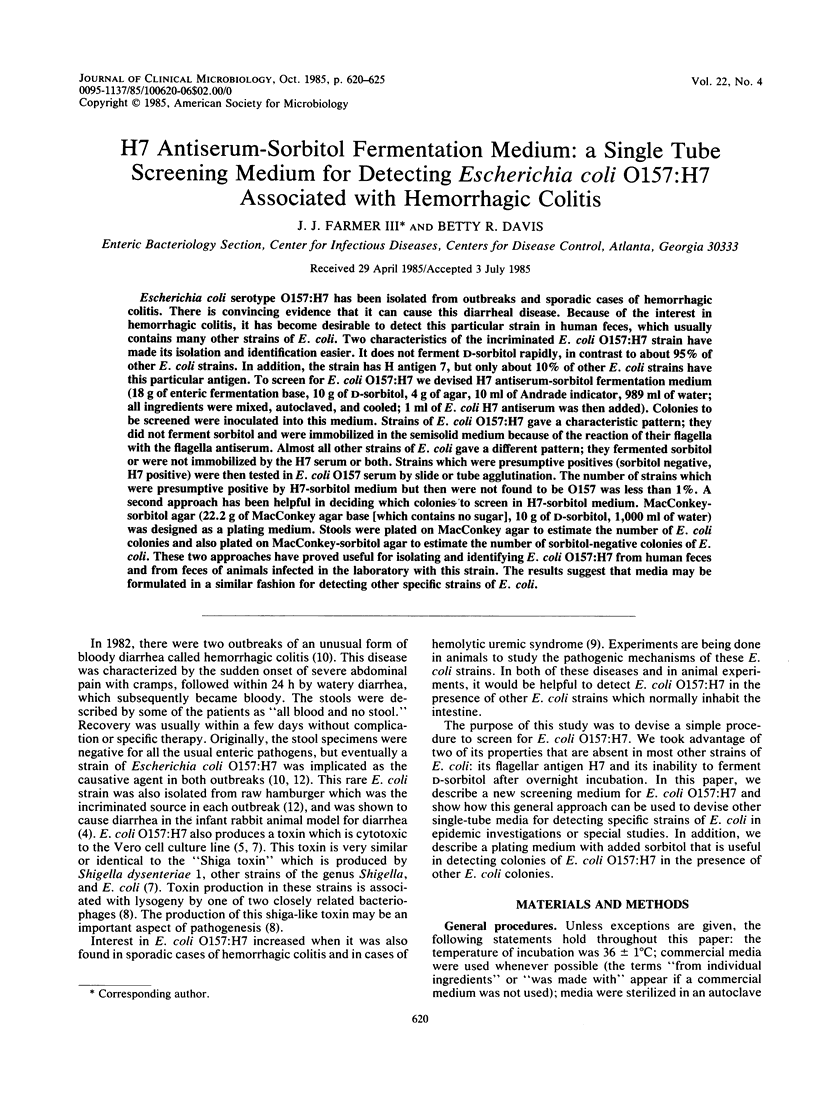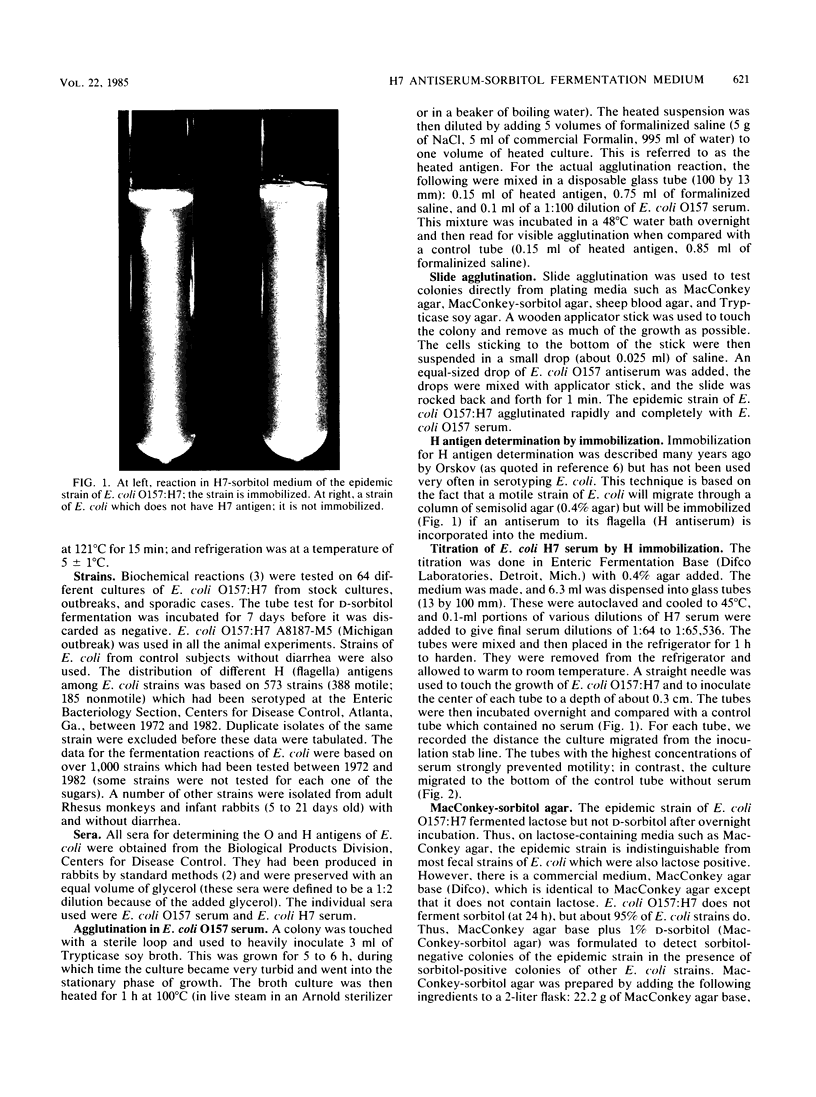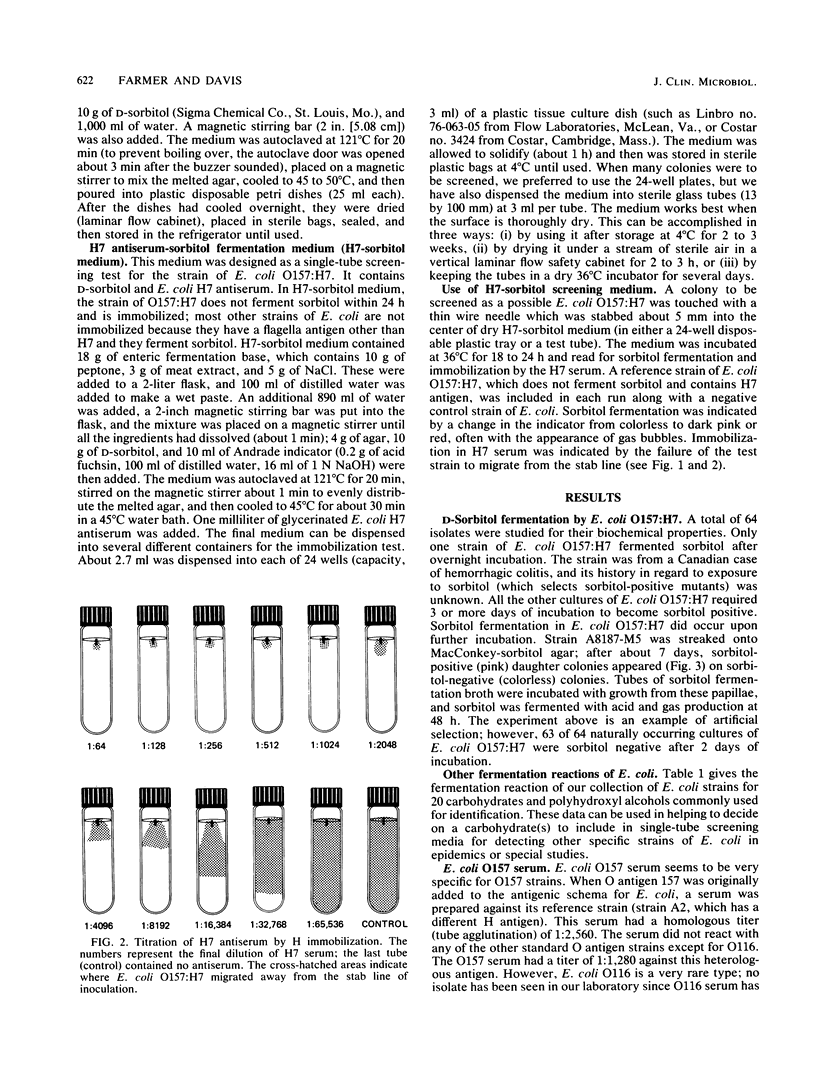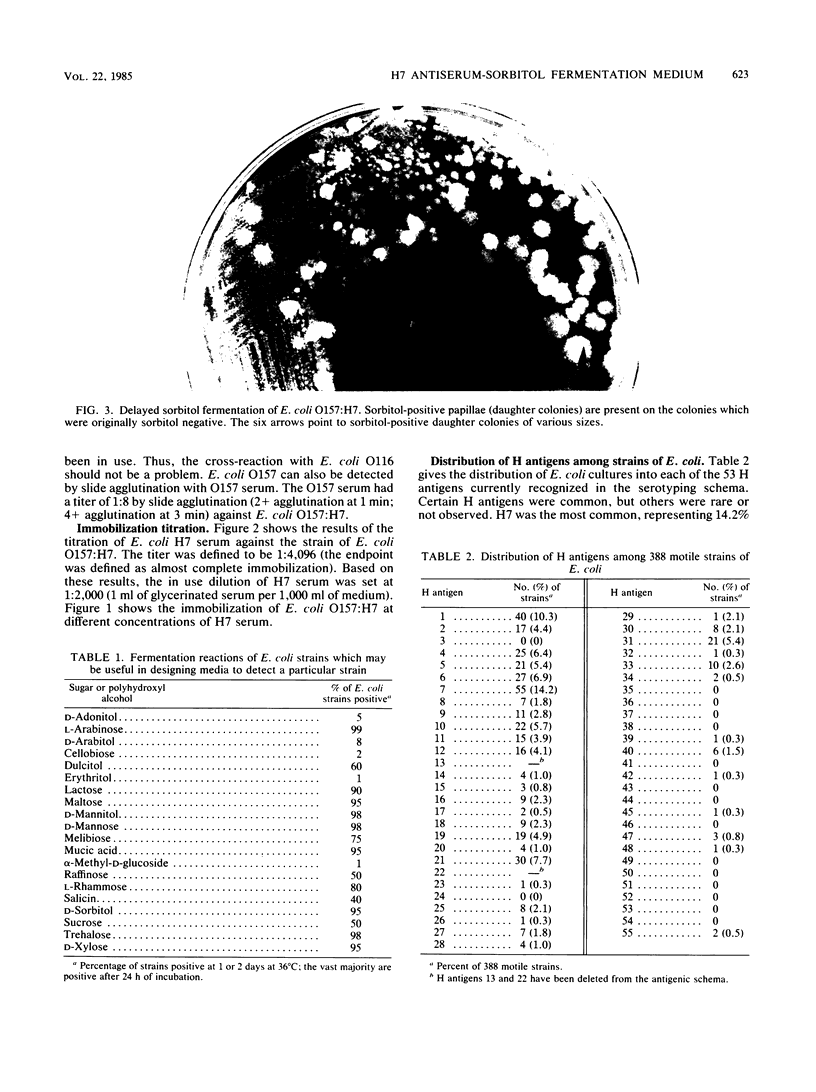Abstract
Escherichia coli serotype O157:H7 has been isolated from outbreaks and sporadic cases of hemorrhagic colitis. There is convincing evidence that it can cause this diarrheal disease. Because of the interest in hemorrhagic colitis, it has become desirable to detect this particular strain in human feces, which usually contains many other strains of E. coli. Two characteristics of the incriminated E. coli O157:H7 strain have made its isolation and identification easier. It does not ferment D-sorbitol rapidly, in contrast to about 95% of other E. coli strains. In addition, the strain has H antigen 7, but only about 10% of other E. coli strains have this particular antigen. To screen for E. coli O157:H7 we devised H7 antiserum-sorbitol fermentation medium (18 g of enteric fermentation base, 10 g of D-sorbitol, 4 g of agar, 10 ml of Andrade indicator, 989 ml of water; all ingredients were mixed, autoclaved, and cooled; 1 ml of E. coli H7 antiserum was then added). Colonies to be screened were inoculated into this medium. Strains of E. coli O157:H7 gave a characteristic pattern; they did not ferment sorbitol and were immobilized in the semisolid medium because of the reaction of their flagella with the flagella antiserum. Almost all other strains of E. coli gave a different pattern; they fermented sorbitol or were not immobilized by the H7 serum or both. Strains which were presumptive positives (sorbitol negative, H7 positive) were then tested in E. coli O157 serum by slide or tube agglutination. The number of strains which were presumptive positive by H7-sorbitol medium but then were not found to be O157 was less than 1%. A second approach has been helpful in deciding which colonies to screen in H7-sorbitol medium. MacConkey-sorbitol agar (22.2 g MacConkey agar base [which contains no sugar], 10 g of D-sorbitol, 1,000 ml of water) was designed as a plating medium. Stools were plated on MacConkey agar to estimate the number of E. coli colonies and also plated on MacConkey-sorbitol agar to estimate the number of sorbitol-negative colonies of E. coli. These two approaches have proved useful for isolating and identifying E. coli O157:H7 form human feces and from feces of animals infected in the laboratory with this strain. The results suggest that media may be formulated in a similar fashion for detecting other specific strains of E. coli.
Full text
PDF





Images in this article
Selected References
These references are in PubMed. This may not be the complete list of references from this article.
- Farmer J. J., 3rd, Potter M. E., Riley L. W., Barrett T. J., Blake P. A., Bopp C. A., Cohen M. L., Kaufmann A., Morris G. K., Remis R. S. Animal models to study Escherichia coli O157:H7 isolated from patients with haemorrhagic colitis. Lancet. 1983 Mar 26;1(8326 Pt 1):702–703. doi: 10.1016/s0140-6736(83)91988-8. [DOI] [PubMed] [Google Scholar]
- Johnson W. M., Lior H., Bezanson G. S. Cytotoxic Escherichia coli O157:H7 associated with haemorrhagic colitis in Canada. Lancet. 1983 Jan 1;1(8314-5):76–76. doi: 10.1016/s0140-6736(83)91616-1. [DOI] [PubMed] [Google Scholar]
- O'Brien A. D., Newland J. W., Miller S. F., Holmes R. K., Smith H. W., Formal S. B. Shiga-like toxin-converting phages from Escherichia coli strains that cause hemorrhagic colitis or infantile diarrhea. Science. 1984 Nov 9;226(4675):694–696. doi: 10.1126/science.6387911. [DOI] [PubMed] [Google Scholar]
- O'Brien A. O., Lively T. A., Chen M. E., Rothman S. W., Formal S. B. Escherichia coli O157:H7 strains associated with haemorrhagic colitis in the United States produce a Shigella dysenteriae 1 (SHIGA) like cytotoxin. Lancet. 1983 Mar 26;1(8326 Pt 1):702–702. doi: 10.1016/s0140-6736(83)91987-6. [DOI] [PubMed] [Google Scholar]
- Remis R. S., MacDonald K. L., Riley L. W., Puhr N. D., Wells J. G., Davis B. R., Blake P. A., Cohen M. L. Sporadic cases of hemorrhagic colitis associated with Escherichia coli O157:H7. Ann Intern Med. 1984 Nov;101(5):624–626. doi: 10.7326/0003-4819-101-5-624. [DOI] [PubMed] [Google Scholar]
- Riley L. W., Remis R. S., Helgerson S. D., McGee H. B., Wells J. G., Davis B. R., Hebert R. J., Olcott E. S., Johnson L. M., Hargrett N. T. Hemorrhagic colitis associated with a rare Escherichia coli serotype. N Engl J Med. 1983 Mar 24;308(12):681–685. doi: 10.1056/NEJM198303243081203. [DOI] [PubMed] [Google Scholar]
- Wells J. G., Davis B. R., Wachsmuth I. K., Riley L. W., Remis R. S., Sokolow R., Morris G. K. Laboratory investigation of hemorrhagic colitis outbreaks associated with a rare Escherichia coli serotype. J Clin Microbiol. 1983 Sep;18(3):512–520. doi: 10.1128/jcm.18.3.512-520.1983. [DOI] [PMC free article] [PubMed] [Google Scholar]




